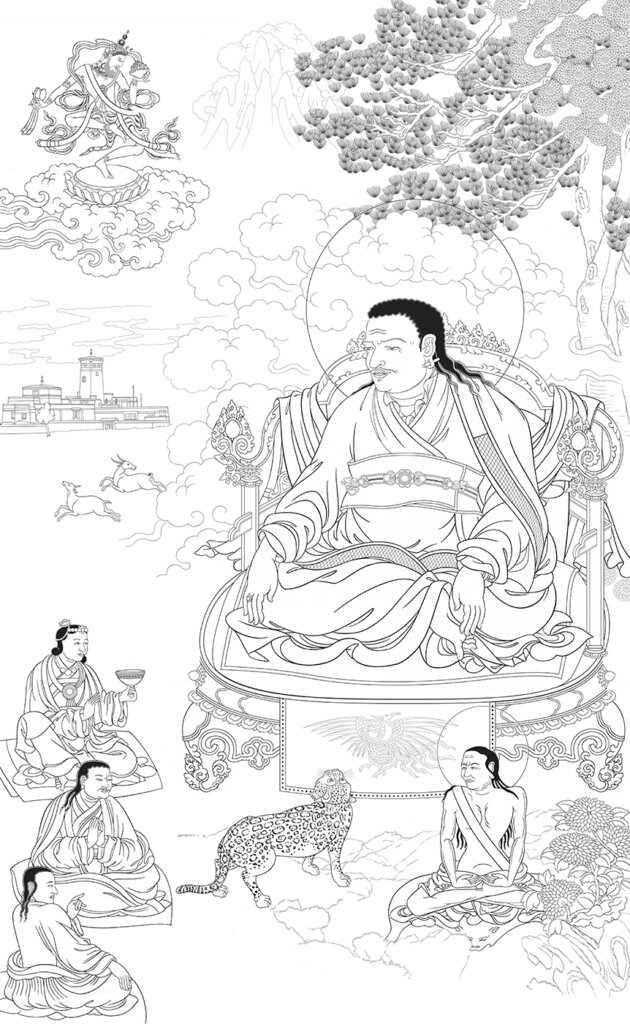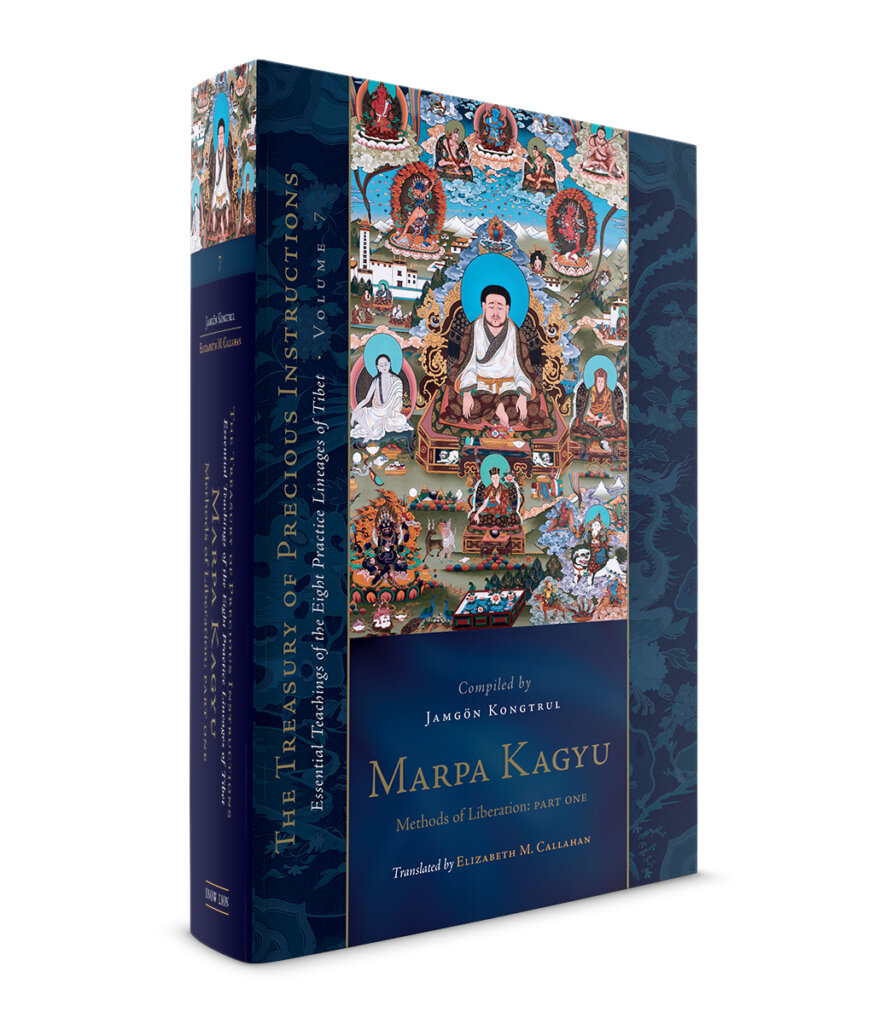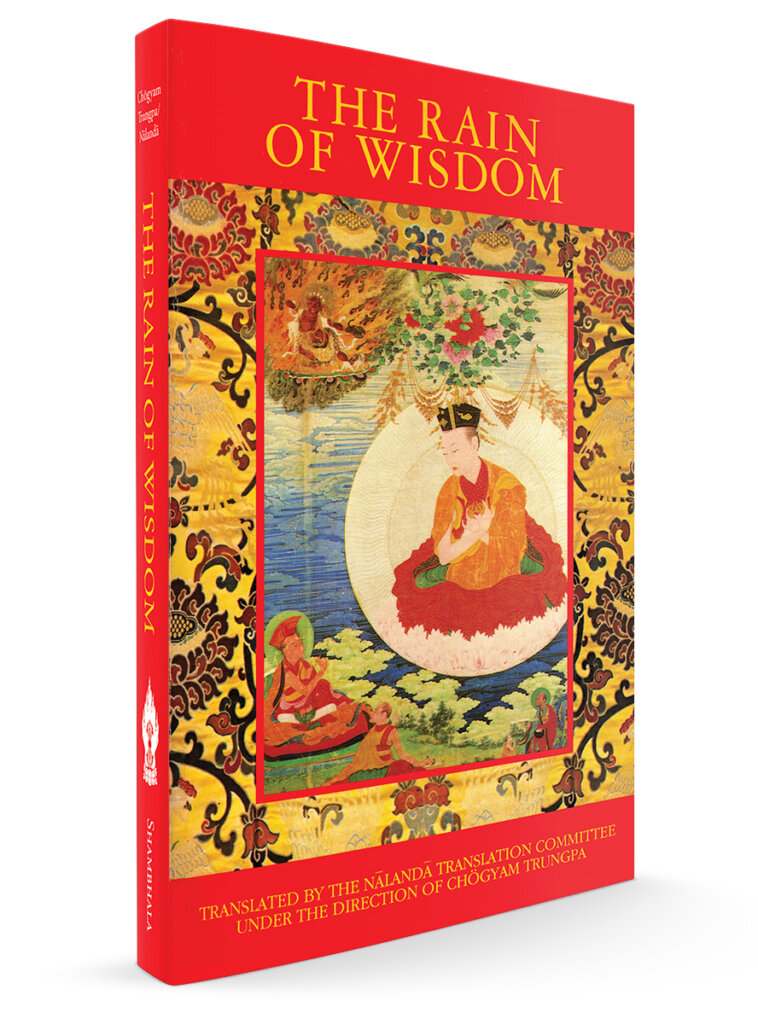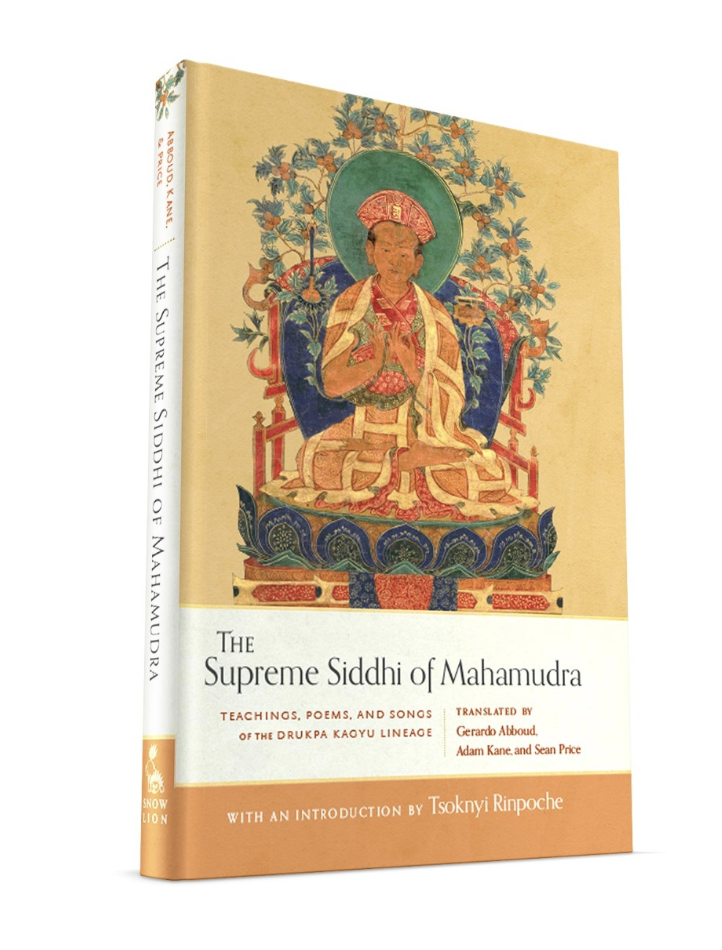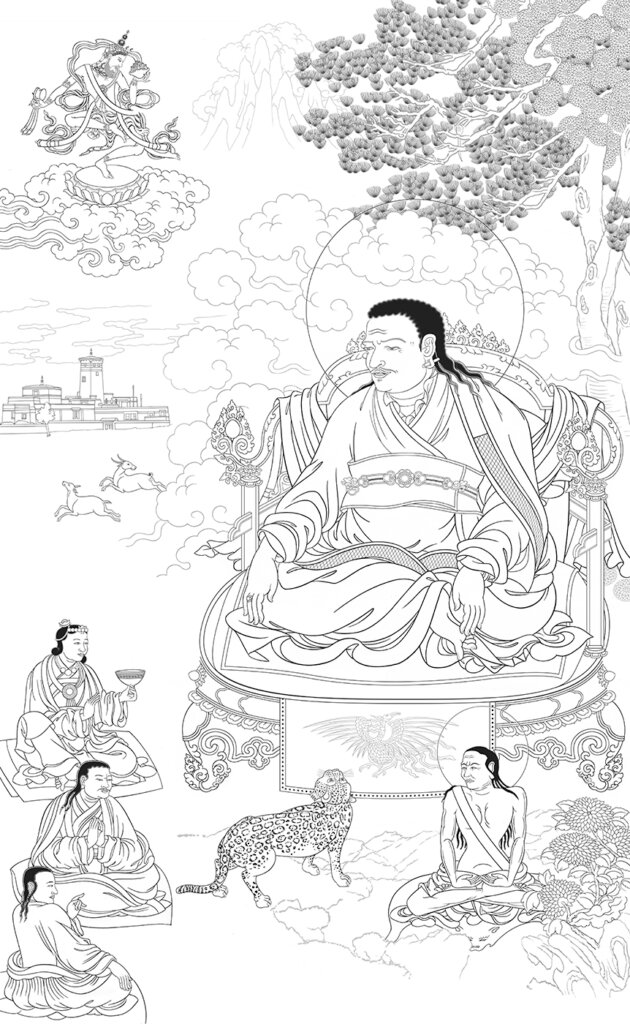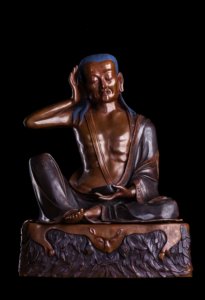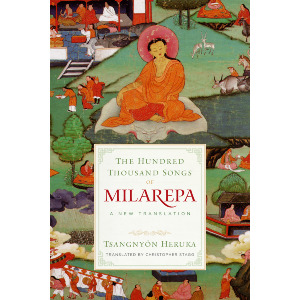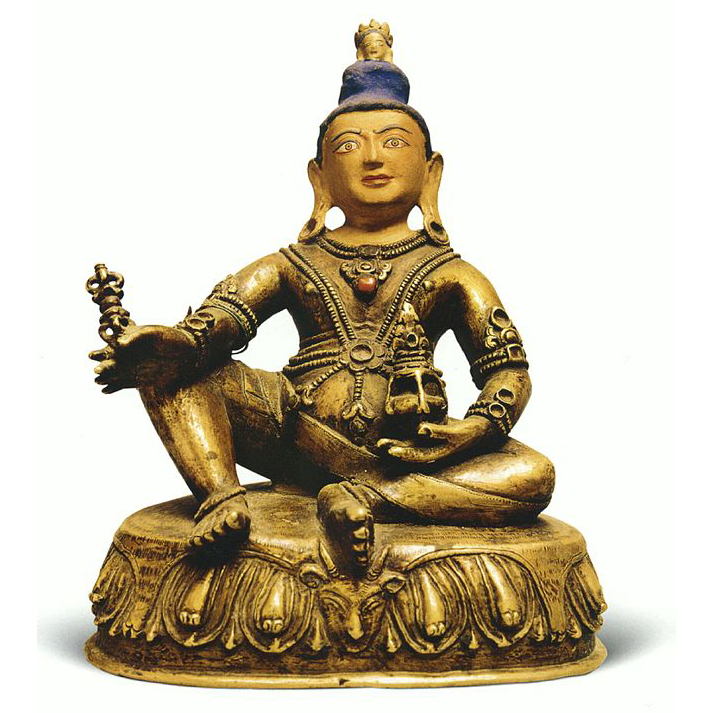

Tsangnyon Heruka
Tsangnyon Heruka (1452–1507), or the “Madman of Tsang,” so named for his eccentric behavior in yogic practice, compiled and arranged this most well-known collection of Milarepa’s songs four centuries after the death of the great yogin. Tsangnyon spent much of his life wandering in the same region as Milarepa and was considered by some to be his emanation.
Tsangnyon Heruka
-
 The Hundred Thousand Songs of Milarepa$45.00- Paperback
The Hundred Thousand Songs of Milarepa$45.00- PaperbackTranslated by Christopher Stagg
By Tsangnyon Heruka
By Milarepa
GUIDES

The following is the beginning of a several page profile of Marpa from Indestructible Truth: The Living Spirituality of Tibetan Buddhism:
Marpa, the Tibetan founder of the Kagyu¨ lineage, represents yet another type of person. Born in 1012 of relatively prosperous parents in southern Tibet, as a young boy Marpa is depicted as possessing a fearsome temper and a violent and stubborn disposition. He is what one might call a holy terror, and while he is still young his parents send him off to be trained in the dharma with a variety of teachers. Marpa soon realizes that one has to make a lot of offerings in order to receive even basic teachings, let alone more advanced ones. Moreover, Tibetan teachers often guard their transmissions jealously, and Marpa is repeatedly rebuffed when he seeks the higher initiations.
Eventually, he comes to the conclusion that to receive the full measure of dharma instruction, he will have to journey to India. His parents capitulate, and Marpa sets off over the Himalayas on a long, tedious, and dangerous journey to India, the first of three trips he will make to the holy land. While staying in Nepal before descending to the Indian plains, Marpa hears of the siddha Naropa. His biography states, ‘‘A connection from a former life was reawakened in Marpa and he felt immeasurable yearning.’’
While many of his Tibetan contemporaries arrived in India and went straight to one or another of the great Indian monasteries for tantric instruction, Marpa takes a different course, bypassing the monastic scene, seeking for his yogin teacher in the forest. Marpa eventually finds Naropa, is accepted as a disciple, and receives extensive instruction and initiation from him.
From the first Marpa Kagyu volume of the Treasury of Precious Instructions:
Marpa Chökyi Lodrö of Lhodrak traveled to India three or four times. He received the sūtras and tantras in their entirety from many scholar-siddhas, Nāropa and Maitrīpa being the foremost among them. In particular, if his earlier and later journeys are added together, he studied with Nāropa for sixteen years and seven months. Through the combination of his listening, reflection, and meditation, Marpa came to dwell in a state of attainment. During his last journey, Nāropa had departed for [the practice of yogic] conduct. Nevertheless, enduring great hardships, Marpa searched for and supplicated Nāropa, finally actually meeting him in Puṣpahari in the North. He spent seven months with Nāropa and received the complete Aural Transmission of Cakrasaṃvara, male and female consorts. In Tibet, the principal disciples upon whom Marpa bestowed his profound dharma were known as the four great pillars. Among them, Mai Tsönpo, Ngok Chödor, and Tsurtön received the entrusted transmission of the explanatory tradition, and Jetsun Milarepa received the entrusted transmission of the practice tradition.
Paperback | Ebook
$34.95 - Paperback
The Life of Marpa the Translator: Seeing Accomplishes All
By Tsangnyon Heruka, translated by Chogyam Trungpa amd the Nalanda Translation Committee
Marpa the Translator, the eleventh-century farmer, scholar, and teacher, is one of the most renowned saints in Tibetan Buddhist history. In the West, Marpa is best known through his teacher, the Indian yogin Naropa, and through his closest disciple, Milarepa. This lucid and moving translation of a text composed by the author of The Life of Milarepa and The Hundred Thousand Songs of Milarepa documents the fascinating life of Marpa, who, unlike many other Tibetan masters, was a layman, a skillful businessman who raised a family while training his disciples.
As a youth, Marpa was inspired to travel to India to study the Buddhist teachings, for at that time in Tibet, Buddhism has waned considerably through ruthless suppression by an evil king. The author paints a vivid picture of Marpa's three journeys to India: precarious mountain passes, desolate plains teeming with bandits, greedy customs-tax collectors. Marpa endured many hardships, but nothing to compare with the trials that ensued with his guru Naropa and other teachers. Yet Marpa succeeded in mastering the tantric teachings, translating and bringing them to Tibet, and establishing the Practice Lineage of the Kagyus, which continues to this day.
Essential Texts by and about Marpa
Hardcover | Ebook
$49.95 - Hardcover
Marpa Kagyu, Part One - Methods of Liberation: Essential Teachings of the Eight Practice Lineages of Tibet, Volume 7
The Treasury of Precious Instructions
By Jamgon Kongtrul Lodro Thaye
The seventh volume of the series, Marpa Kagyu, is the first of four volumes that present a selection of core instructions from the Marpa Kagyu lineage of Tibetan Buddhism. This lineage is named for the eleventh-century Tibetan Marpa Chokyi Lodrö of Lhodrak who traveled to India to study the sutras and tantras with many scholar-siddhas, the foremost being Naropa and Maitripa. The first part of this volume contains source texts on mahamudra and the six dharmas by such famous masters as Saraha and Tilopa. The second part begins with a collection of sadhanas and abhisekas related to the Root Cakrasamvara Aural Transmissions, which are the means for maturing, or empowering, students. It is followed by the liberating instructions, first from the Rechung Aural Transmission. This section on instructions continues in the following three Marpa Kagyu volumes. Also included are lineage charts and detailed notes by translator Elizabeth M. Callahan.
The pieces by Marpa in this volume include:
- Vajra Song on the Meaning of the Four Points: Instructions on the Ultimate Essence, the Mahāmudrā of Nonattention Heard by the Lord Marpa Lotsāwa from the Glorious Saraha
- Trulkhors for the Path of Method and the Caṇḍālī of the Saṃvara Aural Transmission
- Eighteen Trulkhors for Caṇḍālī
Paperback | Ebook
$39.95 - Paperback
The Rain of Wisdom: The Essence of the Ocean of True Meaning
Translated by Nalanda Translation Committee under the guidance of Chogyam Trungpa Rinpoche.
The art of composing spontaneous songs that express spiritual understanding has existed in Tibet for centuries. Over a hundred of these profound songs are found in this collection of the works of the great teachers of the Kagyü lineage, known as the Practice Lineage of Tibetan Buddhism.
The chapter on Marpa, entitled The Grand Songs of Marpa, is 35 pages long and includes Marpa's first departure from India, his dream of Saraha, his third trip to India, his final farewell to Naropa, his third return to Tibet, and the many songs these incidents inspired.
Paperback | Ebook
$27.95 - Paperback
The Great Kagyu Masters: The Golden Lineage Treasury
Compiled by Dorje Dze Öd, translated by Khenchen Konchog Gyaltshen Rinpoche
The Golden Lineage Treasury was compiled by Dorje Dze Öd a great master of the Drikung lineage active in the Mount Kailasjh region of Western Tibet. This text of the Kagyu tradition profiles and the forefathers of the tradition including Vajradhara, the Buddha, Tilopa, Naropa, the Four Great Dharma Kings of Tibet, Marpa, Milarepa, Atisha, Gampopa, Phagmodrupa, Jigten Sumgon, and more.
The profile Marpa is 25 pages long.
Hardcover | Ebook
$24.95 - Hardcover
The Supreme Siddhi of Mahamudra: Teachings, Poems, and Songs of the Drukpa Kagyu Lineage
Translated by Gerardo Abboud, Sean Price, and Adam Kane
The Drukpa Kagyu lineage is renowned among the traditions of Vajrayana Buddhism for producing some of the greatest yogis from across the Himalayas. After spending many years in mountain retreats, these meditation masters displayed miraculous signs of spiritual accomplishment that have inspired generations of Buddhist practitioners. The teachings found here are sources of inspiration for any student wishing to genuinely connect with this tradition.
These translations include Mahamudra advice and songs of realization from major Tibetan Buddhist figures such as Gampopa, Tsangpa Gyare, Drukpa Kunleg, and Pema Karpo, as well as modern Drukpa masters such as Togden Shakya Shri and Adeu Rinpoche. This collection of direct pith instructions and meditation advice also includes an overview of the tradition by Tsoknyi Rinpoche.
This includes a chapter on Marpa's A Vision of Saraha The Essential Importance of the Uncreated Meaning of the Four Syllables of Mahamudra: A Pith Instruction Expressed in a Vajra Song. The pith instruction, the essence of the uncreated found in the meaning of the four syllables of Mahamudra, was revealed to Lord Marpa by the song of Saraha.
Combined with guidance from a qualified teacher, these teachings offer techniques for resting in the naturally pure and luminous state of our minds. As these masters make clear, through stabilizing the meditative experiences of bliss, clarity, and nonthought, we will be liberated from suffering in this very life and will therefore be able to benefit countless beings.
Translator on Gerardo Abboud on The Supreme Siddhi of Mahamudra
Additional Resources on Marpa
Lotsawa House hosts at least eight works by Marpa as well as several where he features. 

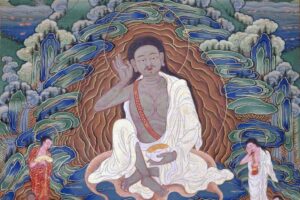
Milarepa, the famous Tibetan yogi, lives on through his joyous, instructional songs and poetry. Both the new translation of The Hundred Thousand Songs of Milarepa, from Christopher Stagg, and Chögyam Trungpa Rinpoche’s exploration of his life in Milarepa: Lessons from the Life & Songs of Tibet's Great Yogi bring new light to the resonance Milarepa’s story still carries centuries later.
Milarepa is remembered for his remarkable determination and personal growth. His inspiring story traces the very familiar, human progression from confusion to clarity. Early in his life, Milarepa came to understand tenents of both privilege and oppression. Though born to a wealthy family, the death of Milarepa’s father left him and his mother at the mercy of his aunt and uncle, who put them to work as servants for their own family. At his mother’s request, Milarepa studied the craft of black magic to be better able to retaliate against their cruelty. Not only was he successful in mastering these magical abilities, he promptly used his skills to take the lives of his aunt and uncle’s entire family. In this way, Milarepa had invited an immense amount of negative karma into his life as a young adult. Soon after committing these crimes, Milarepa’s joy at having aided his mother began to fade, making way for inescapable remorse. This transformation led Milarepa to seek out a master teacher.
“Milarepa’s life story shows how one can progress from being caught in the cycle of confusion, known as samsara, to becoming a student entering and practicing the path of dharma, to eventually becoming a teacher oneself and taking on the responsibility of training others.”
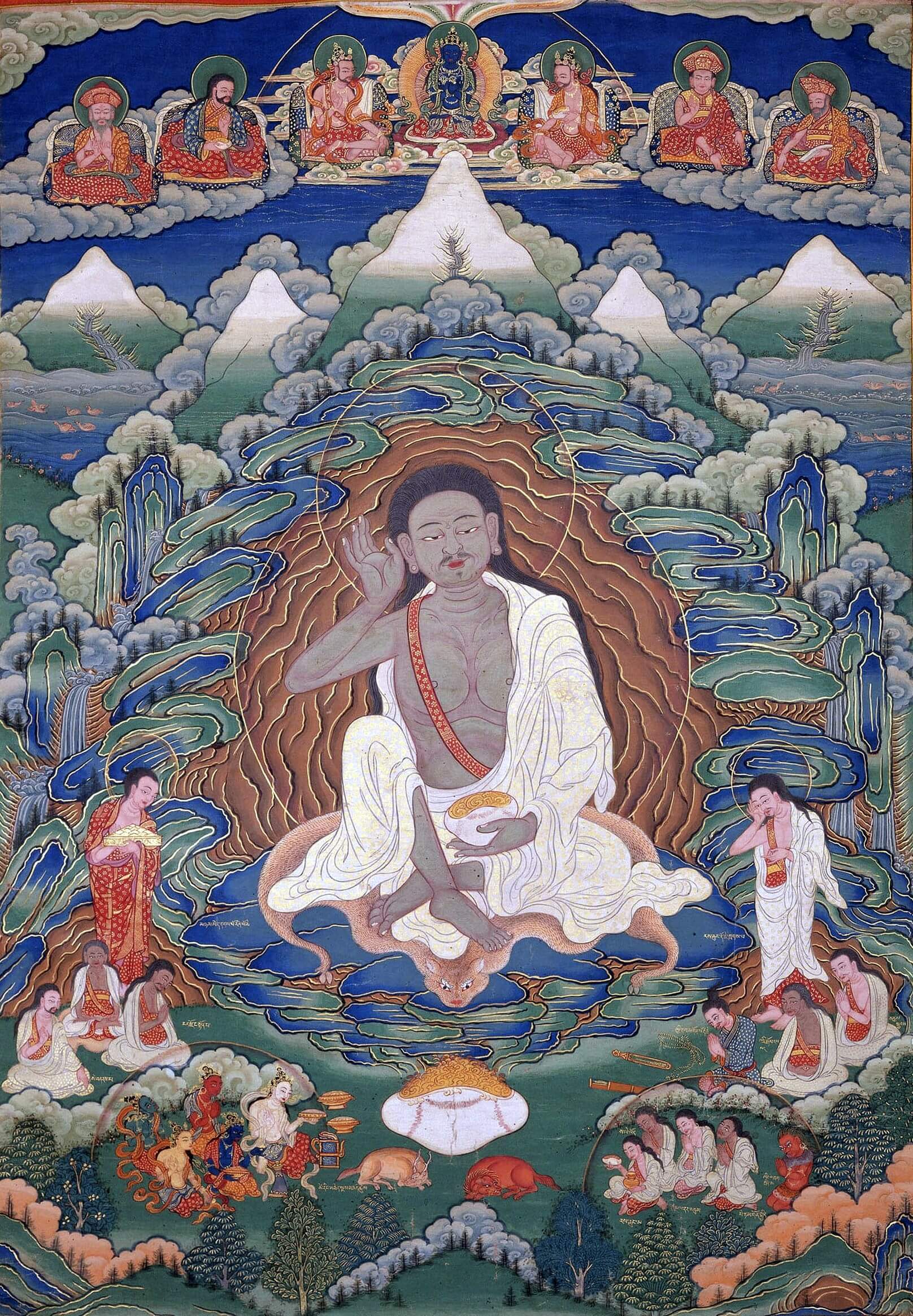
It was not long before Milarepa found Marpa the translator, a Tibetan Buddhist teacher. Marpa was able to see Milarepa’s potential, but knew that the young man would have to process his remorse and uncertainty before beginning his time as a student of the dharma. In order to guide him to a place of preparedness, Marpa set Milarepa to his legendary task of building, destroying, and rebuilding stone towers. This process was intended “to purify the negativity of his past actions, so that Milarepa could begin his studies with fewer obstacles.”
Marpa’s challenge pushed Milarepa “almost to the point of suicide before he agreed to take him on as a student.” Thus began Milarepa’s journey to becoming the yogi and poet that he is remembered as today. He began his simple, solitary lifestyle, living in caves. He often wore little clothing, even in the winter months, and became known as “the cotton-clad one.” Though he did not seek students, word of his practice traveled, and he was sought out by many. It is said that Milarepa “engaged with whoever approached him,” and it is through his teaching that his spontaneous songs and poetry were shared.
“Milarepa sang hundreds of such songs. The standard collection, The One Hundred Thousand Songs of Milarepa (Tib. Mila Grubum) is said to have been compiled by Tsang Nyön Heruka, the “Mad Yogi of Tsang,“ based on transcriptions of the songs that up to then had been only transmitted orally. In this collection, every song comes with a story about how it came about. The collection also includes many descriptions of how Milarepa worked with people, not only through song but in nonverbal ways. We can see how he interacted with his students and how he created situations that challenged them and woke them up. That is, Milarepa did not just sing [songs about] the dharma but he fully embodied the dharma. Because of that, he was able to teach freshly, spontaneously, and with great humor using a variety of skillful means.”
Milarepa's poetic teachings have touched the hearts of his students and admirers for nearly a thousand years. His life represents that of an ideal Bodhisattva, as his deep compassion created the wish of Bodhicitta and motivated him to obtain Buddhahood for the benefit of all sentient beings.
The Song of the Snow
On this auspicious, glorious day,
You male and female benefactors who welcome me with
prostrations,
Along with myself, the yogi Milarepa:
We didn’t perish, and have met. Oh how joyful!
I’m an old man with a treasury of songs,
So I’ll answer your query of my health with this tune;
Listen carefully with focused, attentive minds.
At the very end of the tiger year
And at the beginning of the year of the hare,
On the full moon of the Wagyal month,
Disillusioned with the things of samsara,
I went seeking a secluded retreat
In the remote pastures of the Lachi snowy range.
The land and sky conferred together
And sent down a messenger, a strong wind.
With the elements of water and wind astir,
Black southern clouds gathered in front.
The sun and moon were put into prison.
The twenty-eight constellations were strung on a wire.
The eight planets were put into shackles by edict.
The great Milky Way was tethered down.
The morning star was completely wrapped in mist.
Wind with sleet blew, and finally,
Snow fell for nine days and nine nights;
With the days and nights together totaling eighteen.
The big flakes were big; they fell like thick layers of wool,
Like birds in flight that plummet down.
The small flakes were small; they fell like tiny wheels,
Like bees flying around, then dropping down.
Other small flakes the size of mustard seeds and beans,
Lumped together and fell like balls of sleet.
Snow fell in more sizes than one could count.
High above, the snowy white peaks touched the sky.
Below, the plants and trees were matted and pressed.
The mountains of black donned a blanket of white,
An ocean with waves that were frozen over.
The blue rivers’ waters were put in a shell.
The contour of the land was evened to a plain.
Because this snowfall was so great,
The black-haired people became socked in.
The four-legged creatures were stricken with famine:
Especially the old, weak ones’ sustenance was cut.
Above, the birds’ food source was depleted.
Below, the pikas and mice hid in their stores.
The meat-eating animals were unable to eat.
As for the fate of such sleet and strong wind
And particularly the fate of me, Milarepa:
That blizzard that came down from above,
The strong winter wind of the new year,
And I, the yogi Milarepa’s cloth, these three,
All fought on the side of the high snow mountain.
But I was victorious over the snowfall, and it melted to water.
Though the wind roared powerfully, it naturally subsided,
And my cloth, like fire, was blazing strong!
Two wrestlers contended there in a life-or-death match.
I gave it the edge of my kingly sword.
I was victorious in that fight where the valiant ones were overthrown;
Thus, all dharma practitioners earned some clout
Especially meditators, twice as much;
In particular, my single chandali cloth showed its greatness.
The four gatherings of illness were put on the scale.
Then, inner disturbances were completely vanquished.
Both cold and hot pranas were fully cast out.
Later, the [elements] listened and heeded what was said.
The demon of snow and sleet was suppressed.
Then, all was resolved and completely still.
Though samsara’s brigade tried, it didn’t succeed.
Thus, this yogi won the fight.
I’m my grandfather’s descendant, with the coat of a tiger;
I’ve never fled wearing the coat of a fox.
To my father was born a son of the class of champions;
I’ve never lost in the face of a foe.
I’m of the family of lions, the king of beasts;
I’ve never lived in a snowless land.
Fate has once again played its joke.
If you trust that what this old man says has any power,
The practice lineage teachings will spread in the future,
A few siddhas will also come,
And I, the yogi Milarepa,
Will be renowned throughout the lands.
You disciples will have faith
And fame of you will later spread.
I, a yogi, am very well.
You benefactors, how are you?
RELATED BOOKS
The Hundred Thousand Songs of Milarepa
$45.00 - Paperback
The Life of Marpa the Translator
$34.95 - Paperback
Quotes from Chögyam Trungpa Rinpoche. Text excerpt from Tsangnyon Heruka, translated by Christopher Stagg.

The Offering of the Pigeon Goddess Girl | Excerpt From The Hundred Thousand Songs of Milarepa
In this excerpt, Milarepa is visited by eight goddesses who arrive in the form of pigeons to hide themselves “from people with negativity.” The goddesses perform magic that reveals their bodily forms, and request that Milarepa come to the divine world to teach them the dharma. Milarepa explains the fleeting pleasures of both the divine and material worlds, states his dedication to the realm of humans, and warns that trusting the dharma through suffering and confusion will be difficult. The goddesses offer Milarepa white rice, “the food of meditative concentration and siddhi,” and he offers instructions to remedy the state of samsara through mindfulness.
Chapter Eight: The Offering of the Pigeon Goddess Girl (pp. 87-92)
NAMO GURU
“The Jetsun Milarepa left Yolmo and journeyed to Tibet according to prophecy. In a cave in Kutang, while alone like a rhinoceros, residing in a state of luminosity, there came a pigeon wearing a dangling gold earring. As though prostrating, the pigeon bowed her body and nodded her head as she circumambulated Milarepa many times. Then she flew in the direction of Immaculate Rock. Knowing that this was the invitation of a spirit, the Jetsun went over to her. There sat a pile of white rice, which the pigeon began offering to him with her beak. As before, she prostrated and circumambulated, and then flew away. The Jetsun, with great joy and amazement, sang this song of realization:
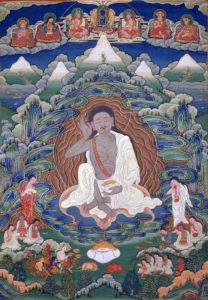
E MA HO!
Marpa of Lhodrak, who has been so kind,
By remembering you from my heart, I meditate with you there.
Again and again I supplicate you to never be separate from me.
Mixing one’s mind with the guru’s is so blissful.
A la la! The nature of appearances
Is pointed out as birthless dharmakaya,
And they merge, uncontrived, with the state of dharmakaya.
I’m not concerned whether some views are high and others low.
This uncontrived mind is so blissful indeed!
This nature of mind is luminosity-emptiness.
That luminosity-emptiness is pointed out as awareness
And they merge in the uncontrived, innate state.
I’m not concerned over good or bad meditation.
This uncontrived mind is so blissful indeed!
The sixfold collection clear right in its own place.
Is pointed out as nondual, free of perceiver and perceived,
And both pleasure and pain are merged into one.
With this body, uncontrived, in its primordial state,
I’m not concerned over right or wrong conduct.
This uncontrived mind is so blissful indeed!
The fruition is the nature of dharmakaya.
The variety is pointed out as nirmanakaya.
Everything, when encountered, is merged with the state of liberation,
But I have no hope of any fruition.
This uncontrived mind is so blissful indeed!

When Milarepa had sung this, the pigeon returned, this time with seven companions. Just as before, they prostrated and circumambulated the Jetsun. He thought, “These are most certainly spirits. I will have to see if they speak honestly or not.”
“Who are you all, and why have you come here?” he asked them. The devis performed magic revealing their own bodily forms. The leader of them, who had come previously, said, “We are all devis who have faith in you and have come to request the dharma. Please teach us.”
In response to this request, the Jetsun sang this song of realization:
Lord, emanated guru who is so wondrous
With no small compassion, please grant your blessing.
You whose miraculous conduct is in accord with the dharma,
Who appeared before in a pigeon’s form,
You eight wondrously beautiful devis,
If you wish to practice the sublime pure dharma,
Please keep the meaning of this song within your minds.
Generally, the mundane comfort in the world,
Though it seems very pleasant, quickly departs.
In particular, the view of you noble ladies,
Though it seems high, there’s nothing stable about that.
The householder’s way with its suffering of samsara,
Though it seems very good, there is much pain involved.
Excellent children of noble bloodlines,
If they’ve no resourcefulness themselves, they’ll have much
distress.
Students who have an excellent guru,
If their conduct is poor, then to samsara they fall.
You emanated pigeon goddesses,
Though you request the dharma, really trusting it is hard.
If you must practice the genuine dharma,
You must see as faulty beyond any doubt
The good qualities of this mundane world.
Understand adverse conditions that arise in this life
To be the companion to enlightenment.
For this man, adverse conditions are incredibly kind;
You should also understand it this way!
Thus he sang. Then the devis, smiling, all said, “Yes, we will do so!” and they prostrated and circumambulated him.
The Jetsun asked, “Why is it that you appeared before as pigeons?”
They replied, “You have no attachment at all to this life or your own benefit. In order to accomplish enlightenment for the benefit of others, you have abandoned distractions and remain alone, engaged in meditative concentration without interruption. Seeing this with our own divine eye, with faith, we came to request the dharma. We appeared in this way to hide ourselves from people with negativity. Now, please come to our divine realm and teach the dharma.”
The Jetsun then said, “For the entirety of this life, I will remain in the realm of humans to benefit beings. Since the divine realms are also without any essence, there is no need for them. Even if I were to go there, I would have nothing different to say than this. You all should practice in this way.”
Then he sang this song of realization:
I bow at the feet of Marpa from Lhodrak.
Father guru, with your blessing, please grant me siddhi.
You eight beautiful female goddesses:
This white rice, the food of meditative concentration and siddhi,
Has revived my body, and my practice will flourish.
I’ll repay this kindness with the dharma.
Listen attentively and keep it in your minds.
The white and radiant celestial royal seat,
Though you’ve managed to get to it, is without any essence.
The youthfulness and beauty of you devis,
Though it’s a pleasant appearance, will quickly go.
This illusory deception, a magical display,
Though the enjoyment is great, is a cause for downfall.
The sufferings of the six beings of samsara,
When one ponders them, are deeply disheartening.
Should you wish to practice dharma for their sake,
Then supplicate the three precious jewels;
Meditate on the six beings as your own parents;
Make offerings to the guru lord;
Give generously to the impoverished;
Dedicate your virtue for the six beings’ benefit;
Always meditate on the uncertainty of the time of death;
With one’s body as the yidam deity,
Utter the profound speech of mantra;
Meditate on self-aware emptiness wisdom;
And continuously place your own mind as your witness.
Then they said, “We are ignorant sentient beings with afflictions firmly entrenched within our minds. Please teach us a method on which to rely for remedying this state with mindfulness.”
Then he sang this song of realization in reply:
I bow at the feet of Marpa who is so kind.
Grant your blessing that remedies arise well in my mind-stream.
You devis who are endowed with faith,
If you want to practice in a continual way:
Inside, meditate with the concentration of shamatha;
To abandon activity is one great ornament.
Outside, stably take hold of the antidote;
To relax body and speech is one great ornament.
Continuously take the seat of mindfulness;
To have few affairs is one great ornament.
When adverse conditions give the mind difficulty,
Be on the lookout for the arising of aggression.
When encountering money and things of desire,
Be on the lookout for the arising of attachment.
When the weapons of harsh speech fall upon you,
Be on the lookout for your ears’ delusion.
When accompanying friends that are equal to yourself,
Be on the lookout for the arising of jealousy.
When praise and honor come your way,
Be on the lookout for the arising of pride.
At all times and in every way
Tame the evil demons within your mind-stream.
Should a hundred learned and righteous ones speak,
ere would be no better advice than this.
Now practice with joy in meditation!
When Milarepa had sung that, the devis rejoiced with great delight. Then, again transforming into pigeons, they went off to the celestial realm.”
The Hundred Thousand Songs of Milarepa
$45.00 - Paperback

